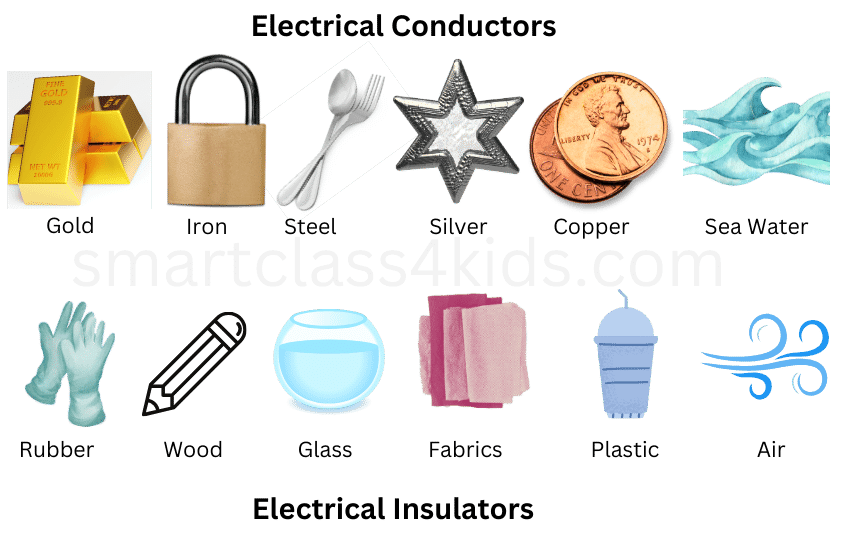Electricity Conductors and Insulators
Electricity Conductors and Insulators Examples

What is a conductor?
Let’s understand the conductor with an example. Conductors are a kind of smooth road for electricity. Like how cars can move easily on a well-built road, energy can move easily through certain materials. Materials like copper, aluminum, and iron are common examples of electrical conductors. When we employ wires made from these materials in our gadgets, they effectively transport electricity from one location to another. For safe and efficient electricity flow, it’s important to use the right materials.
All metals are good conductors of heat and electricity. Silver, copper, and gold are the most highly conductive metals. That is why the electric wires are made of copper and aluminum.
So, all the objects that are made of metal are conductors of electricity. For example, iron nails, coins, aluminum foil, keys, etc. are conductors of electricity because they are made of metal.
Carbon is the only non-metal that conducts electricity when it is in the form of graphite. The human body is also an electric conductor, but not as good as metals. That is why we get electric shocks if we touch an uncovered electric wire.
Pure water does not possess electrical conductivity properties. The presence of minerals, or metallic solids, in the water is the only reason to make it an extremely effective electrical conductor.
That’s why we should dry our hands before touching or using electric appliances or switches.
Why are metals good conductors of electricity?
Examples of electrical conductors
- Copper.
- Aluminum.
- Silver.
- Gold.
- Mercury.
- Iron.
- Brass.
- Steel.
- Bronze
- Graphite.
- Platinum.
- Lemon Juice,
- Water.
- Human Body.

What is an insulator?
Some materials that do not allow electricity to move through them are called insulators of electricity. They are non-conductors of electricity.
Materials like rubber, wood, glass, and thermocol are common examples of insulators. The objects made of these metals do not allow the electric current to pass through.
Insulators are used to keep us safe from electricity. That is why the wire that carries electric current to our computer or electronic devices is covered with a rubber or plastic-like insulator that protects us from electric shock.
Air is a non-conductor of electricity. Do you know what happens when an electric switch is in the off position?
When an electric switch is turned off, there is air between the ends of the wires connecting to it. Because air is not an electrical conductor, no electricity flows between the ends of the wires in the switch, and thus the bulb does not light up.
The atoms in insulator material tightly hold on to their electrons, which stops electric current from moving easily through them.
Examples of electrical insulators
- Rubber
- Plastic
- Glass
- Air
- Wood
- Paper
- Cloth
- Mica
- Quartz
- Porcelain
- Silk
- Wool
